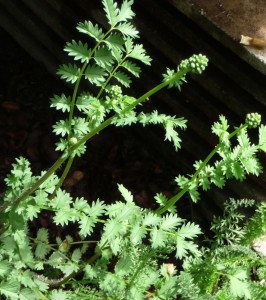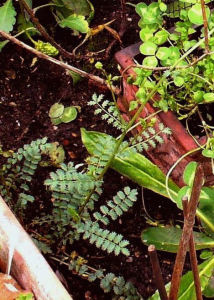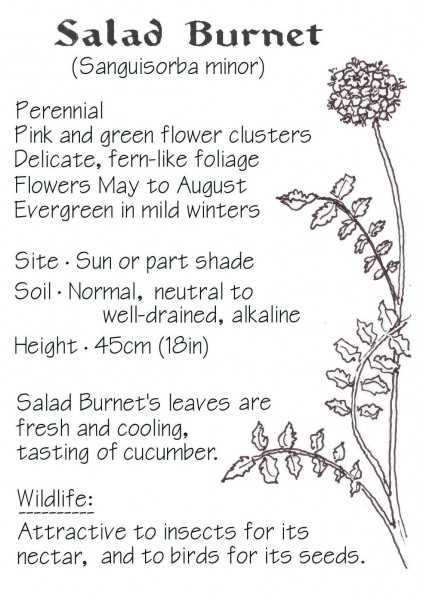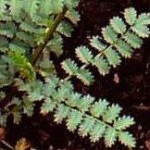SALAD BURNET (Sanguisorba minor)
Europe, NW Africa, W Asia, Pakistan
‘Burnet or Salad Burnet is one of those wonderful old-fashioned herbs that have sadly been relegated to the lower leagues in terms of popularity, which is a pity as it is quite versatile for the cook and gardener alike.
An ancient herb brought to Britain in the sixteenth century, it initially found favour with the Tudors as an ornamental herb in manicured gardens. Francis Bacon (1561-1626) is known to have liked the decorative nature of the plant. It was planted along pathways ‘to perfume the air most delightfully, being trodden on and crushed’.
The delicate leaves’ subtle cucumber flavour is used in cold drinks, salads and as a flavouring for sauces and vinegars; they make a useful addition to compound butters and once chopped can be folded through crème fraîche as an interesting flavouring for summer soups… lovely when combined with melon. A lovely addition to summer sandwiches and, unlike cucumber, they don’t make the bread soggy.’
http://www.seedaholic.com/salad-burnet.html
Bees Favourite.
‘Salad burnet is named by the Royal Horticultural Society (RHS) as perfect for pollinators; its rich nectar attracts bumble bees, butterflies and other insects, which in turn helps support the eco-system and promote bio diversity.’http://www.meadowmat.com/wildflower-species/salad-burnet
This Norfolk website includes Salad Burnet in the ready-made rolled up mats of wildflowers that it sells.
Wine and Drunkard’s Thirst
Some websites look at the use of Sanguisorba minor in cooking and healing.
“One writer suggested that “the leaves stripped into wine and dronken, doth comfort and rejoice thee hart and are good against the trembling and the shaking of the same”…
Finally, if you are prone to over imbibe from time to time try pouring boiling water over a handful of salad burnet leaves, leave to cool, strain out the leaves and drink the liquid “as a cure for, or an alleviant of, drunkard’s thirst”.
http://www.pennywoodward.com.au/salad-burnet/
At The Priory of St Pancras in Priory Park, Lewes (open throughout the year, entrance free), a recreated herb garden grows plants that monks would have used for medicinal, culinary and ceremonial purposes.
‘The garden was likely made up of themed compartments with the Mount, the Dripping Pan and the Convent Garden in the northeast and the Pigeon House Garden and Pond Garden in the southwest. It is possible that the work was undertaken [by Thos Sackville] in anticipation of a visit by Elizabeth I in 1577 – a visit which was cancelled due to threat of plague.’ Paul Everson
‘The herb garden was part of a major project to recreate as accurately as possible an original infirmary garden. It was undertaken in 1983 by pupils of Lewes Priory School & students of Lewes Technical College with support of the Rotary Club of Lewes & many other individuals and organisations under the guidance of the Lewes Priory Trust.
The idea was conceived by Anthony Freeman, a local history teacher & Schools Liaison Officer of Lewes Priory Trust, who wanted to stimulate public interest in the remains of the Cluniac Priory. The project set out to recreate a herb garden close to the original site & stocked with herbs that were likely to have been in the original garden & to use, as far as was practically possible, materials and layouts consistent with medieval practice. Arthur Franklin, a historian also from Priory School produced a ground plan for the project, based on the ‘ideal’ plan of St. Gall (c. 895AD).’
http://www.lewespriory.org.uk/the-original-herb-garden
http://www.lewespriory.org.uk/what-are-we-growing
Salad Burnet in Highbury
Sanguisorba minor has the reputation of being a pernicious weed in some of the countries where it has been introduced. The Tudor favourite did grow here in our wildflower square for a season. However, our young plant never got the chance to be a weed, and only grew to a modest size. Its delicate flavour was enjoyed, we assume, by the garden’s gourmet slugs, snails and mice.
Other names: Burnet, Fodder Burnet, Drummer Heads, Garden Burnet, Lamb’s Ears, Little Burnet, Sheep’s Burnet, Small Burnet




